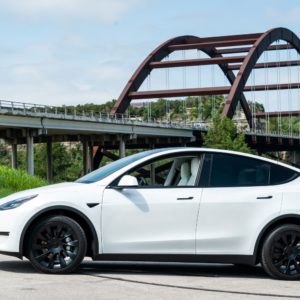Have you ever wondered how much a Tesla weighs? You might have seen it on the company’s website or the owner’s manual. However, you probably didn’t commit it to memory.
Knowing the curb weight of a Tesla can prove helpful, especially if you own or plan to acquire one. Let’s look at the curb weights of various Tesla models.
How Much Does a Tesla Weigh?
Let’s look at the curb weights of four Tesla models: The Model 3, Model S, Model Y, and Model X.
Tesla Model 3 Weight
The Tesla Model 3 was introduced in 2017 and updated in 2021. It’s the lightest among the many Tesla models. Each of its three trims has a different curb weight.
First is the Tesla Model 3 Standard Range Plus. Powered by a single motor and fitted with a rear-wheel drive, it’s the lightest Model 3 trim, with a curb weight of 3,862 lbs.
Next is the Long Range trim. It weighs 4,034 lbs, mainly due to the second electric motor.
Finally, the Performance trim adds all-wheel drive to its dual motors. The curb weight of this high-performance is 4,048 pounds.
Tesla Model S Weight
First shown in 2012, the Tesla Model S is older than all other Tesla models save for the Roadster. It’s also the second largest and heaviest Tesla, second only to the massive Model X.
The original trim is the Tesla Model S Long Range. The all-wheel-drive vehicle has a curb weight of 4,561 lbs. Two electric motors generate 670 horsepower, enabling the EV to go from 0 to 60 mph in 3.1 seconds. It can cover up to 405 miles.
Tesla introduced the Plaid trim for the Model S in 2021. Also featuring all-wheel drive, the new trim has a curb weight of 4,766 lbs. It uses three motors that generate 1,020 horsepower and add extra weight. Capable of hitting 60 mph in 1.99 seconds, the Tesla Model S Plaid pays for the speed with a slightly shorter range, only 396 miles.
Tesla Model Y Weight
The Tesla Model Y is the company’s newest EV offering. Introduced in 2019, it seats seven people and has two trims–Long Range and Performance. Both Model Y trims run on dual electric motors and have all-wheel drive.
Both trims of the Tesla Model Y share the same curb weight of 4,416 lbs. Their weight puts them in the middle of the pack.
Performance-wise, the dual motors of the Tesla Model Y Long Range trim generate 346 horsepower and propel the SUV from 0 to 60 mph in 4.8 seconds. Its batteries give it a maximum range of 330 miles.
The Tesla Model Y Performance trim has 450 horsepower, enabling it to go from 0 to 60 mph in 3.5 seconds. However, it can only go as far as 303 miles.
Tesla Model X Weight
The Model X is Tesla’s heaviest car. It has two trims, both of which have all-wheel drive.
Its Long Range trim has a curb weight of 5,185 lbs. Introduced in 2016, it runs on two electric motors.
Meanwhile, the curb weight of the high-performance Tesla Model X Plaid trim is 5,390 lbs. The increase in weight comes from a third electric motor that generates more power.
The dual motors of the Tesla Model X Long Range deliver 670 horsepower and can go from 0 to 60 mph in 3.8 seconds. It has a range of 348 miles.
First manufactured in 2021, the Tesla Model X Plaid trim’s three motors produce 1,020 horsepower. It accelerates from a standstill to 60 mph in 2.5 seconds. Its range isn’t far behind the LR one at 333 miles.
Tesla Models From Heaviest to Lightest Curb Weights
Here are the Tesla models arranged from heaviest to lightest according to their curb weight:
- Model X Plaid: 5390 pounds
- Model X Long Range: 5185 pounds
- Model S Plaid: 4766 pounds
- Model S Long Range: 4561 pounds
- Model Y Long Range and Performance: 4416 pounds
- Model 3 Performance: 4048 pounds
- Model 3 Long Range: 4034 pounds
- Model 3 Standard Range Plus: 3862 pounds
- Tesla Roadster (Gen. 1): 2723 pounds
What Is Curb Weight and GVWR?
Curb weight is the vehicle’s weight when it has a full tank of fuel and carries all standard equipment. It doesn’t factor in the weight of passengers, cargo, or nonstandard gear. It’s considered the closest weight to the vehicle’s actual weight.
The formula for determining curb weight is the Gross Vehicle Weight Rating (GVWR) minus the payload. Payload is alternatively called passenger/cargo capacity.
GVWR is the maximum safe weight a vehicle can bear as designed by the manufacturer. It’s the total of the vehicle’s net weight and the weight of standard equipment, passengers, fuel, and cargo. It’s a safety standard that warns you about overloading your car or truck.
You can find the GVWR on the Safety Compliance Certification Label. The door jamb on the driver’s side usually bears a tire specification level that includes the vehicle’s maximum capacity in payload or passengers/cargo capacity.
To give you an idea of how to calculate curb weight, imagine a vehicle with 4,000 lbs GVWR and a 1,000 lbs payload or passenger/cargo capacity. You can get its curb weight through the formula 4,000 lbs minus (-) 1000 lbs = 3,000 lbs.
Manufacturers usually publish their vehicle’s curb weight in vehicle sourcebook materials given to official dealers. In case they’ve failed to release the value for your vehicle’s model or model year, your dealership can help you find the curb weight.
It doesn’t take much effort to find the curb weight of a Tesla. Having this information on hand can prove helpful when you need to load it on a trailer or have it towed by another vehicle.
Any information provided on this Website is for informational purposes only and is not intended to replace consultation with a professional mechanic. The accuracy and timeliness of the information may change from the time of publication.

























